Programmatic SEO is your ticket to faster, scalable page optimization. Instead of manually optimizing each page for search engines, why not leverage automation tech to get solid results in a fraction of the time?
However, programmatic SEO with AI isn’t magic. It still requires plenty of hands-on expertise and serious dedication. As always, we never recommend using 100% AI without human oversight.
Likewise, this approach relies on big datasets and powerful SEO tools, all of which you’ll need to be/become proficient in to succeed.
In this guide, we’re going to demystify programmatic SEO and teach you exactly how to implement it so you can start generating more qualified pageviews and driving revenue.
- What Is Programmatic SEO, Exactly
- Origins and Evolution of Programmatic SEO
- Programmatic SEO vs. Traditional SEO
- When and Why You Should Use Programmatic SEO
- How Programmatic SEO Works
- How to Set Up the Foundation Before Scaling
- 15 Proven Programmatic SEO Strategies for 2025
- Examples of Programmatic SEO in Action
- Programmatic SEO Mistakes to Avoid
- How to Measure Success in Programmatic SEO
- Final Thoughts
What Is Programmatic SEO, Exactly
Programmatic SEO is a way to automate SEO at scale. Essentially, businesses use code or scripts to generate and optimize large volumes of web pages for search engines, with the goal of capturing long-tail keyword traffic. Instead of doing this all by hand over several months, you can now do it in moments.
Here are a few of the key concepts behind programmatic SEO for ecommerce and other industries:
- Automation at scale - programmatic SEO uses templates and structured data to create pages automatically, without the need for manual creation.
- Template-based page generation - simply use a single page template to generate many pages with different content inputs.
- Long-tail keyword targeting - a programmatic approach is especially handy for targeting long-tail, low-competition search queries.
- Data-driven content - using structured datasets like product specs or reviews.
- Technical SEO - needs good internal linking, URL structure, fast loading times, schema markup, and avoiding thin/duplicate content penalties
Origins and Evolution of Programmatic SEO
SEO has come a long way since the days of keyword stuffing. In the last decade, long-tail SEO and structured data has gradually taken over. This is partly down to Google’s improving algorithms, which increasingly favor high-quality, relevant content over content that simply “hits” specific keywords.
During that time, template-based websites have also emerged. Directories like Yelp and TripAdvisor found that they could create massive numbers of pages for listings (like “apartments in San Francisco”) using a combination of templates and databases easily and quickly. Likewise, keyword tools like SEMrush were making it easier to identify thousands of long-tail queries.
Today, programmatic SEO AI is making the process even more efficient. AI lets businesses generate unique, useful content for a huge range of pages at scale and at low cost.
Programmatic SEO vs. Traditional SEO
Traditional SEO still has its place. In fact, it’s the better option if you’re focused on brand-building and thought leadership or you want to rank for competitive, broad keywords with in-depth content.#
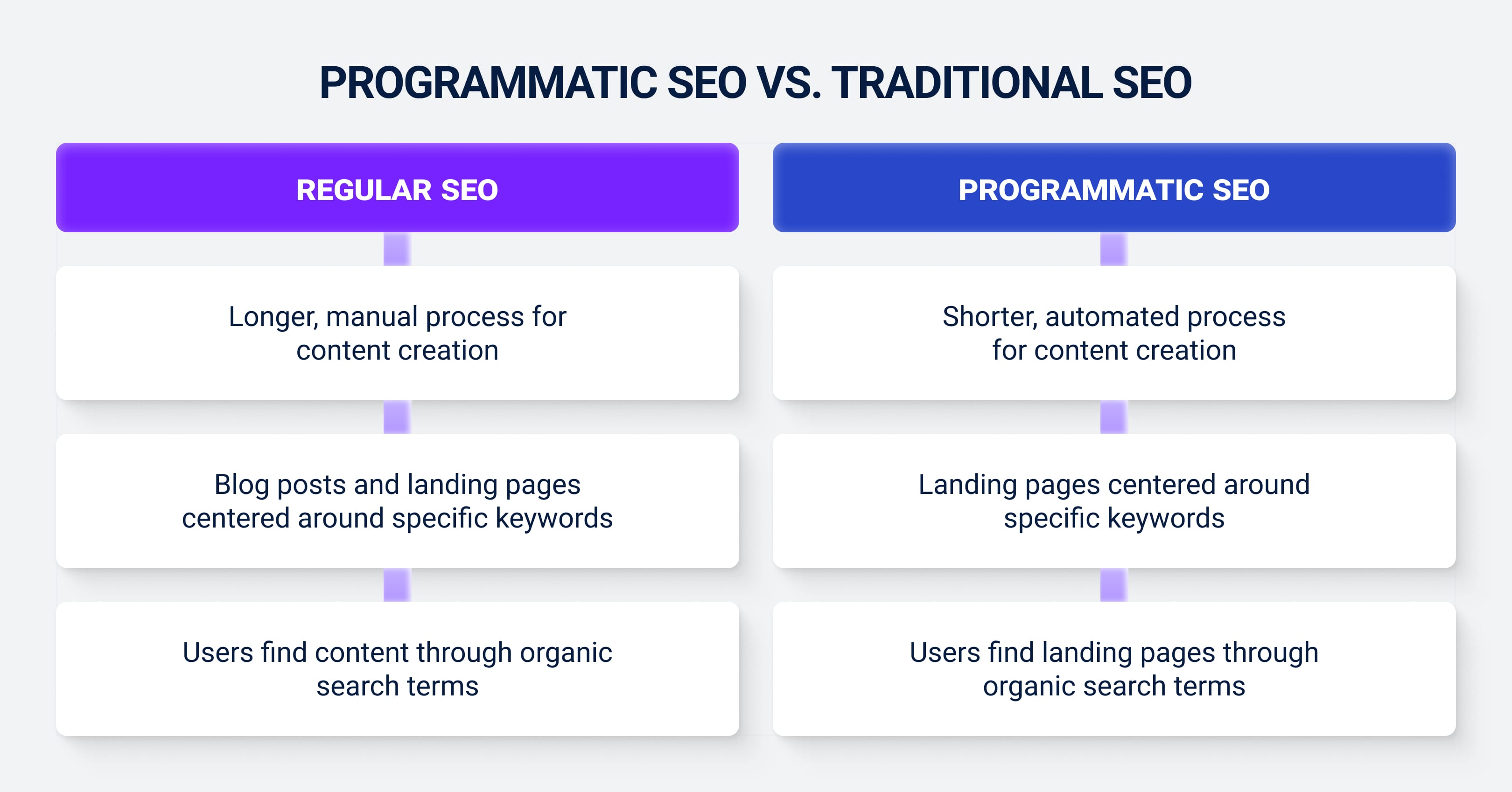
However, programmatic SEO dominates when it comes to high volumes of similar but distinct search queries, particularly if you have large structured datasets at your disposal.
Here’s a comparison table of programmatic SEO vs. traditional SEO:
| Aspect | Programmatic SEO | Traditional SEO |
|---|---|---|
| Approach | Automated | Manual |
| Volume | Potentially thousands of pages | Dozens of pages |
| Content Creation | Structured data & AI | Handwritten |
Target Keywords | Long-tail, low-competition, high-intent queries | Head terms and short to mid-tail queries |
| Scalability | Highly scalable | Limited by time and capacity |
| Technical Skills | Requires dev/engineering | Can be done by marketers (with SEO knowledge) |
When and Why You Should Use Programmatic SEO
Programmatic SEO isn’t right for every situation. It’s best when:
- You have the data - you need plenty of structured, repetitive data like products and locations that can create distinct pages with the same format.
- You need to target long-tail queries - fighting for niche, intent-rich searches? Programmatic SEO is perfect.
- You want to build at scale - programmatic SEO is the quickest way to build thousands of optimized pages simultaneously.
- You’re building an inventory - specific kinds of websites, say, marketplaces or SaaS tools, suit this approach better.
- You can support it - programmatic SEO relies on coding knowledge, so dev plus SEO teams get the best results.
How Programmatic SEO Works
Programmatic SEO is a technical approach to optimization. That being so, it rests heavily on technical know-how and expertise.
Here’s how it actually works:
The Core Building Blocks: Data, Templates, and Scale
There are three fundamental elements behind all programmatic SEO:
- Structured data - you need a deep dataset (for example, product listings or job titles).
- Page templates - programmatic SEO is nothing without a great, flexible template that is both recognizable and dynamic.
- Scale - the goal is to create hundreds or thousands of pages, each of which targets a specific query variation, at the same time.
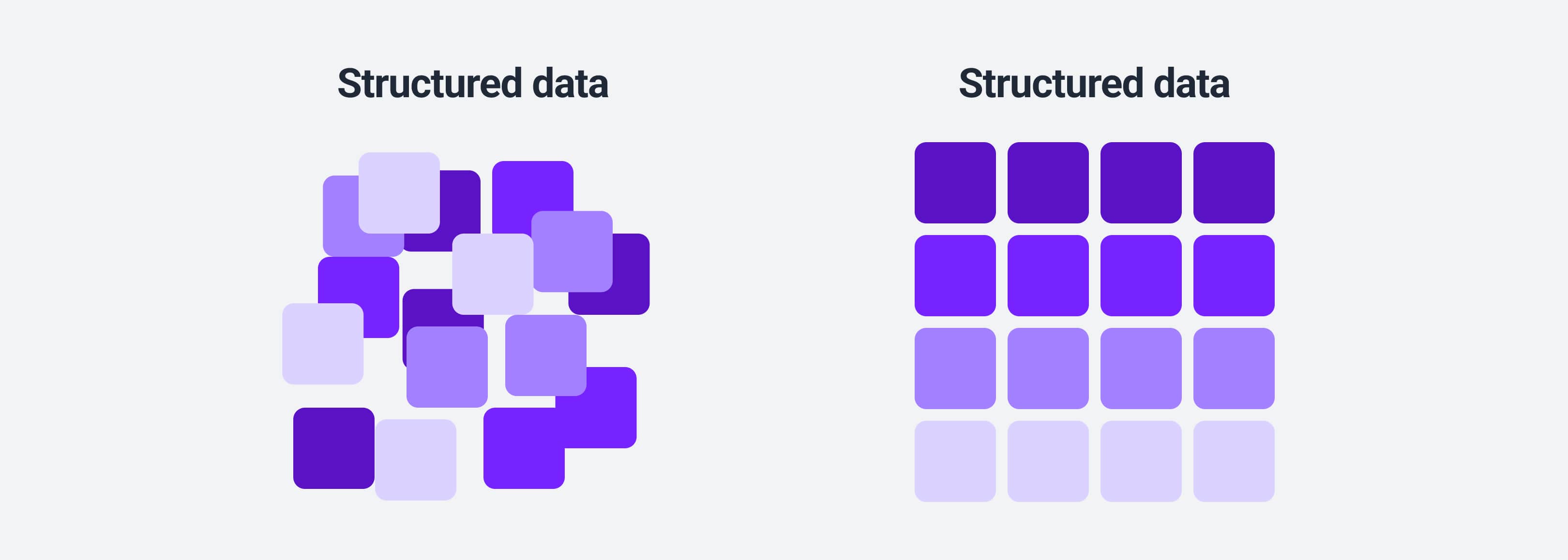
Role of AI, APIs, and Automation in 2025
This type of optimization wouldn’t be possible without automation tools. Programmatic SEO AI has opened the doors to a world of opportunities. Here are the tools that make the biggest difference:
- AI-generated content - LLMs can now create high-quality content for individual pages that doesn’t sound “robotic”. Note: we don’t recommend generating 100%-AI content, as this can damage your search rankings according to Google’s E-E-A-T principles. You should always go over AI content before publishing.
- APIs - external APIs are crucial for keeping your pages fresh. They can feed in live data like prices and reviews and make sure everything’s up-to-date and dynamic.
- Automation tools - automation tools make it all possible. Workflows from Zapier streamline the process and custom scripts can automate everything from keyword expansion to internal linking.
Your tech stack is at the heart of your programmatic SEO efforts. To start with, you’ll need strong CMS capabilities. You have a few options here:
- Traditional CMS - less scalable without strong dev support, but still possible with plugins and custom post types.
- Headless CMS - this gives you more options when it comes to flexible, API-driven content. However, requires dev expertise.
- Custom stacks - startups with engineering teams using frameworks like Next.js or React often prefer to create their own custom stack.
You should also think about your hosting setup. After all, you’ll need to handle large volumes of generated pages and your hosting infrastructure needs to be sufficient.
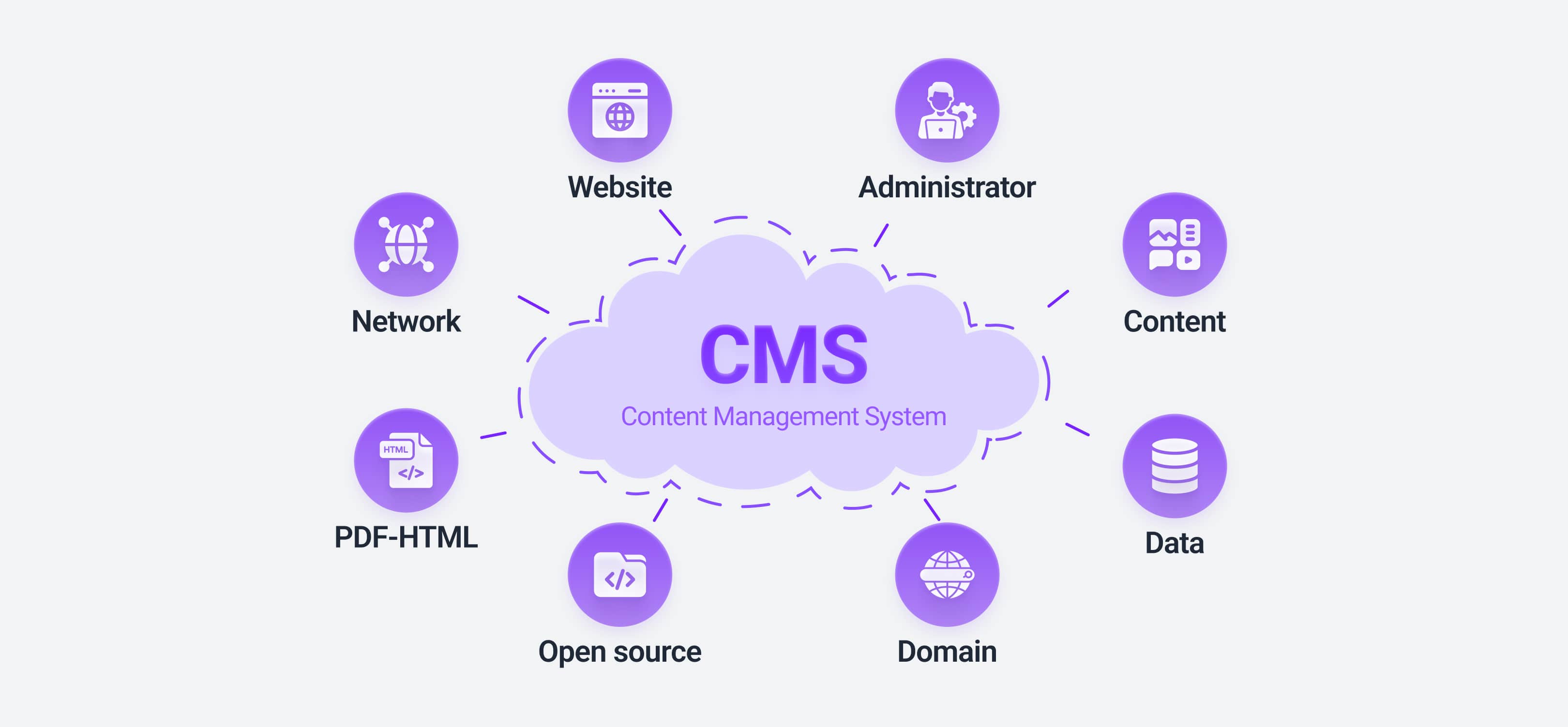
Indexing and Crawling Challenges at Scale
Simply churning out thousands of keyword-optimized pages doesn’t necessarily mean big results. That’s just the modern-day equivalent of keyword stuffing. Plus, there are other, technical issues that can block the road to higher revenue through programmatic SEO:
- Crawl budget - Google actually sets a finite limit on its crawl capacity for each site and page (15MB for HTML and supported text-based files). So, poor internal linking and duplicates can waste your crawl coverage.
- Indexing delays - you need proper XML sitemaps and internal links to get indexed as quickly as possible.
- Content quality - AI content generation is a handy tool, but always remember that “thin” (low-quality) pages simply won’t get indexed or rank highly. Always make sure your pages have quality reviews in place!
- Canonicalization - proper use of canonical tags helps avoid duplicate content problems if page content overlaps.
How to Set Up the Foundation Before Scaling
It’s impossible to scale your SEO without a rock-solid foundation. Without proper keyword strategies in place from the very beginning, you risk generating thousands of low-quality or poorly indexed pages that go nowhere.
Keyword Research for Programmatic SEO
Long-tail and intent-rich keywords are clearly fundamental to programmatic SEO strategies. You’re not just targeting a handful of high-volume terms like you would with traditional SEO methods. You’re trying to uncover high-value patterns.
Here’s how to do just that:
- Find core entities - separate into categories, like “services” or “features”.
- Use modifiers - gradually build up descriptive keywords to form long-tail combinations. Think “cheap”, “near me”, “best”, “for kids”.
- Analyze competitors - look at large aggregators or marketplaces and reverse-engineer their SEO patterns using tools like Ahrefs.
- Group by intent - put each query into one of these categories: informational, transactional, or navigational.
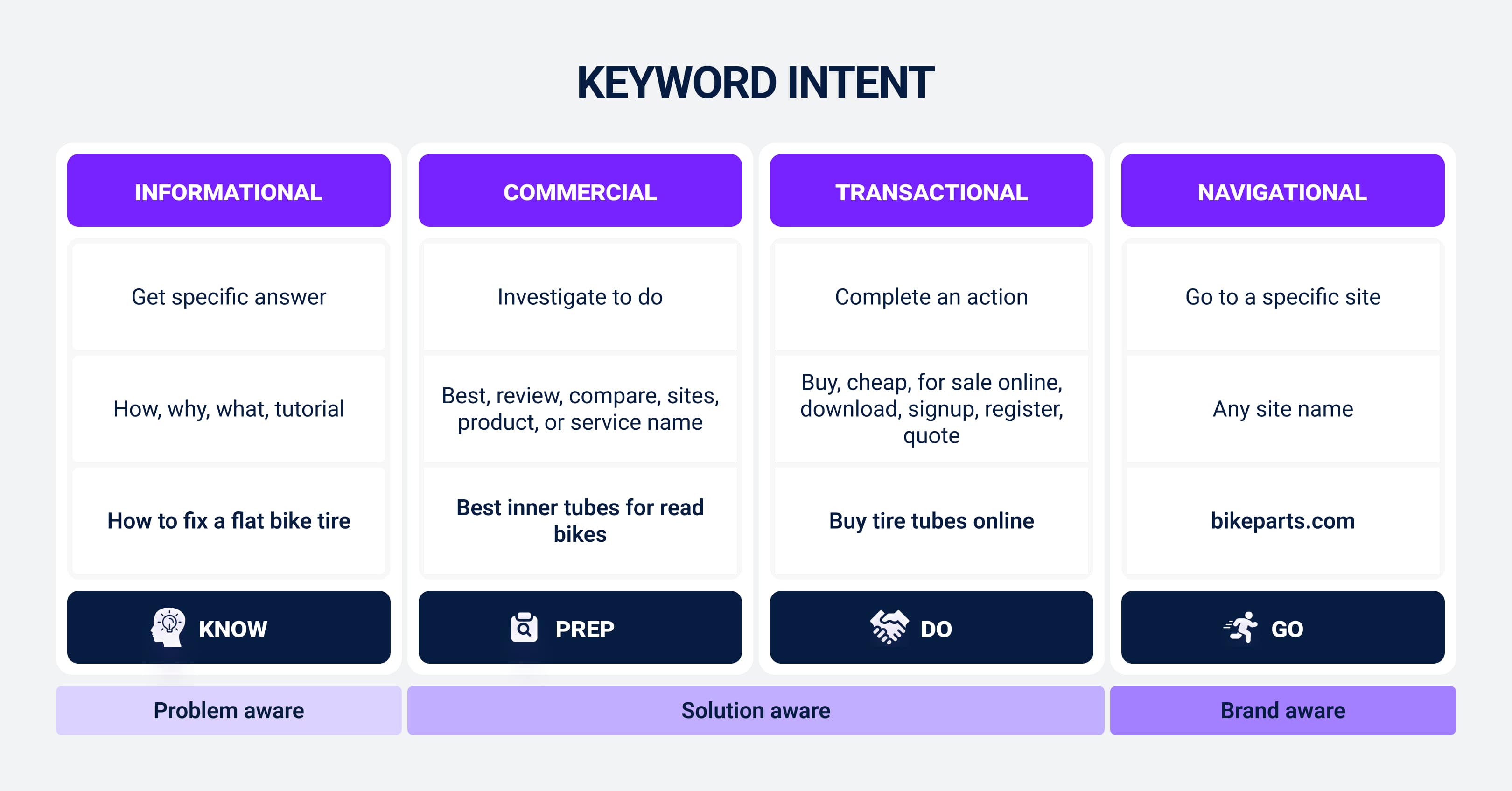
Mapping Keywords to Intent-Based Page Templates
The other key aspect of programmatic SEO aside from keywords is templates. So, the next step after gathering your keywords is to organize them into template types based on search intent.
Here’s what we mean:
- Location-based - “nail salons in [City]”
- Comparison-based - “best [tool] for [use case]”
- Attribute-based - “[product] under $100”
- Integration-based - “connect [tool A] to [tool B]”
Remember: each keyword cluster has to link to a distinct page that solves a user problem.
Content Structuring: Categories, Filters, and Modifiers
You want users and search engines to have an easy time navigating your site. With that in mind, use these strategies:
- Define a clear taxonomy
- Use filters/modifiers as dynamic content variables
- Always think about user experience
The easier it is for users and search engines to navigate your site and get to your valuable information, the more satisfied they’ll be and the higher your ranking.
Creating a Scalable URL Architecture
Unfortunately, messy and complicated URLs are all too common. The best URLs clearly reflect the hierarchy of your data.
Here’s how to do that:
- Use hyphen-separated, lowercase URLs
- Try to avoid dynamic parameters like “?id=123” where possible. Clear paths like “/tools/google-sheets/integrations/slack” are much better.
- Make it logical for both users and crawlers
15 Proven Programmatic SEO Strategies for 2025
It’s one thing knowing the technical aspects of how to implement scalable programmatic SEO. It’s another to drive results. For that, you’ll need proven programmatic SEO strategies that promise high performance.
Here are 15 top strategies our experts recommend:
1. Build Scalable Location Pages
A huge percentage of Google searches, especially on mobiles, have local intent. That could be people looking for a solution in their town, or their region more generally. Either way, targeting geo-specific queries like “dog groomers in Brooklyn” or “gyms near San Diego with childcare” is a great way to cash in on location-based searching.
We recommend using templates powered by city or zip code area, which is ideal for service businesses or directories targeting local buyers.
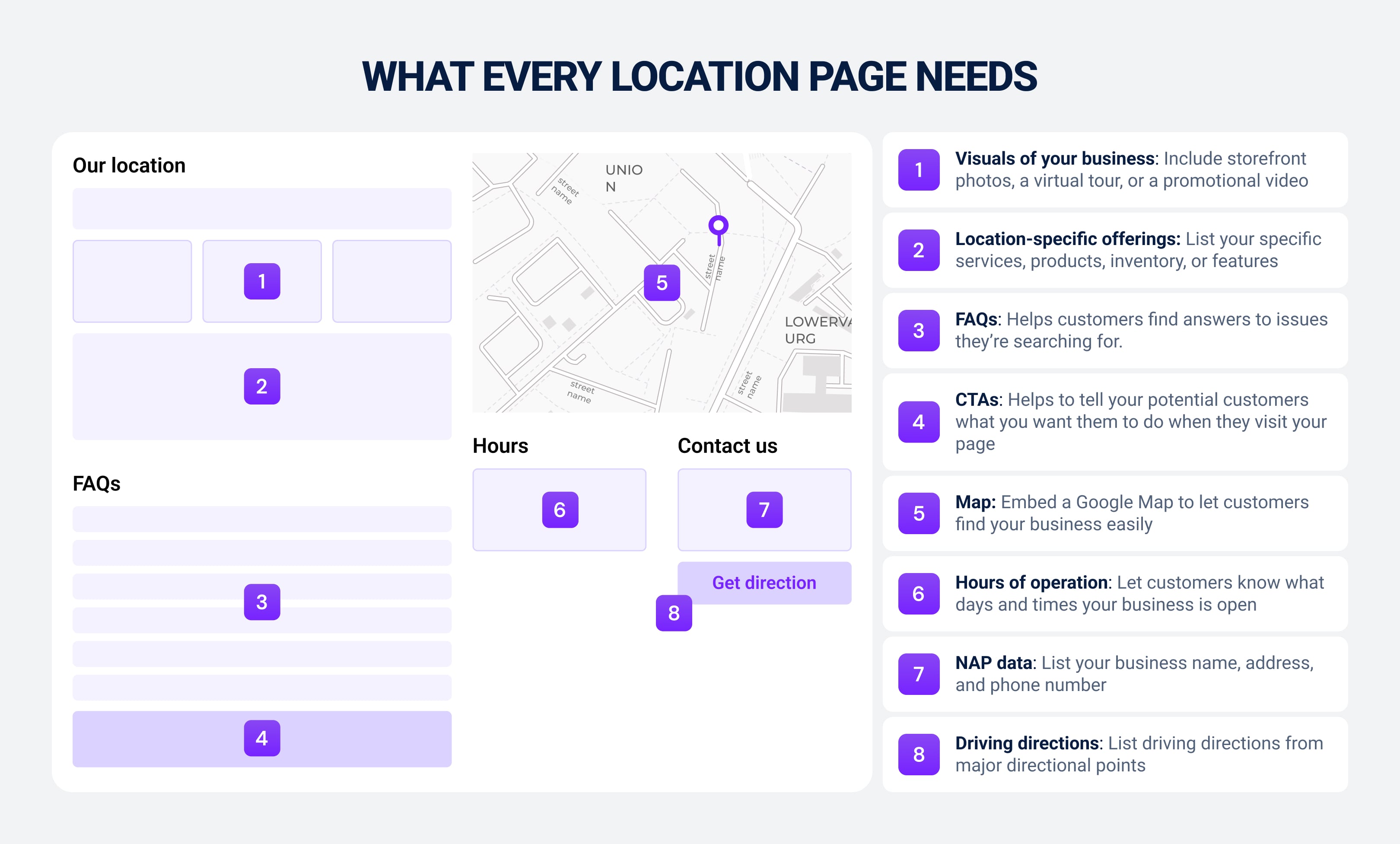
2. Create Product/Service Feature Combinations
One great way to attract more high-intent users is to combine core offerings with attributes or use cases. Here are two examples:
- “CRM for freelancers”
- “Laptops with long battery life for travel”
Firstly, this increases long-tail coverage. Secondly, it shows users from the very beginning what a product is specially designed for, not just what it is.
3. Generate ‘Best [X] for [Y]’ Template Pages
The proven “best [X] for [Y]” template is one of the highest-converting formats you could ask for. It has high buyer intent and positions your product/service with a use case automatically. Think:
- “Best hiking boots for wide feet”
- “Best budget X software for small teams”
Combine product data plus user reviews plus content scoring to rank and display results.
4. Integrate User-Generated Data via APIs
Reviews and user metrics can seriously enhance your pages, so it’s a good idea to integrate this data into your SEO. Consider using APIs to pull in data from:
- Community forums like Reddit
- Google Maps data, like “highest-rated Xs”
Real user input gives your content a level of trustworthiness users value. Plus, it helps keep your pages dynamic and interesting.
GROW YOUR INSTAGRAM FOLLOWING VIA OUR CELEBRITY CAMPAIGNS
Leverage the power of the worlds A-list celebrities to grow your Instagram every month
VIEW CAMPAIGNS5. Use Internal Search Data to Fuel Page Ideas
One of the best ways to find unserved searched patterns, or gaps in your SEO strategy, is to mine your site’s search logs and analytics.
In other words, see what your current users are searching for. For example, if a considerable amount of people are looking for “invoice template for freelancers”, that could point you in the right direction as to what to create next.
6. Leverage Public Data Sets for SEO Pages
It doesn’t necessarily have to be your own data forming the backbone of your programmatic SEO efforts. There are actually plenty of public data sets (for example, government or academic sets) that you can use to inform your SEO.
For example, explore:
- Census data for city profiles
- FDA food databases for nutrition product pages
- Github repos for open-source tool directories
Then, all you have to do is pair this structured data with helpful, human-first content to rank for the niche keywords that will drive your traffic!
7. Build Comparison Pages at Scale
When leads reach the decision-making stage, side-by-side comparison pages can really make the difference. Luckily, these pages are easy to replicate. Simply use external data to fill out side-by-sides between your product/service and its competitors.
For example, if you offer a CRM, make pages like:
- [Your CRM] vs. Monday CRM
If you offer a website builder, try:
- [Your builder] vs. Squarespace
Use templating to create consistent and search-engine-optimized comparison pages that answer all your prospect’s questions.
8. Create Dynamic FAQ Pages with Schema Markup
Combine internal search logs from your site with long-tail queries from People Also Ask boxes to generate useful FAQ sections that directly address user needs. Not only does this drive organic traffic to your site, but shows you’re there to help, too.
Include FAQ schema to boost visibility in search and increase CTR.
9. Automate Internal Linking with Silo Logic
Internal linking is crucial. However, not just any internal linking. Links have to be relevant and useful. It’s important to get your internal linking system right.
Luckily, you can automate this with logic-based internal linking systems:
- Link from category to subcategory
- Link between related pages using tags or taxonomy
This boosts crawlability and distributes authority across your programmatic page network.
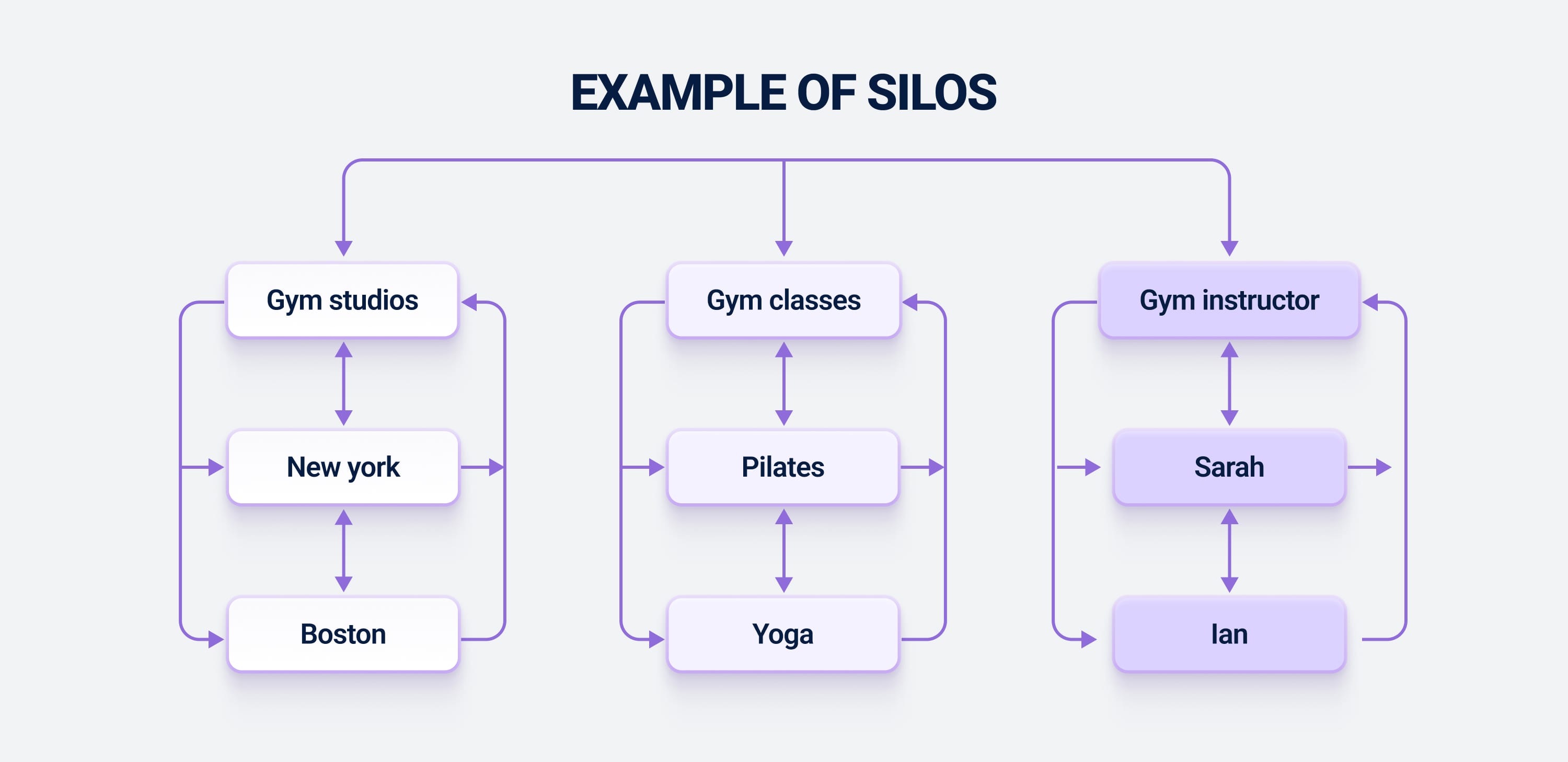
10. Programmatic Meta Titles and Descriptions
Meta information is essential for traffic. You can use internal data and keyword logic to generate:
- Meta titles like, “Top 10 Laptops for Designers in 2025”
- Meta descriptions summarizing features and ratings, among other things
We recommend going one step further and testing different formulaic approaches. When you analyze CTR data, you may be able to find meta-info patterns that can improve your metrics.
11. Integrate Real-Time Pricing or Stock Data
APIs give your site much-needed real-time credibility. You can use them to show up-to-date information like:
- Ticket prices
- Product availability
- Room rates
This does two things: firstly, it can help win rich snippets or visibility in shopping search results, which drives clicks. Secondly, it makes your pages more trustworthy.
12. Combine Reviews & Aggregated Ratings
85% of buyers trust online reviews as much as they trust a personal recommendation from a friend. Positive reviews act as social proof. You should exploit the fact they offer third-party validation.
Programmatically pull in ratings from different sources (like Trustpilot) to create a “meta-rating” per item or service. Then, enhance pages with review schema for more SERP visibility.
13. Target Featured Snippets Programmatically
Featured snippets now show above other SERP results in Google. They offer a chance to get your site front and center when done right.
All you need to do is structure your content to directly answer search questions. For best results:
- Add tables, lists, definitions
- Use H2s and H3s that mirror the query
You can use AI to fill in templated answers that are clear and snippet-friendly. However, always check AI output and edit when necessary before publishing!

14. A/B Testing Programmatic Page Variants
Use A/B testing software to test multiple versions of aspects like:
- H1s
- CTAs
- Layouts
- Content depth
This software will tell you which versions perform best. By analyzing performance data (like clicks and bounce rates), you may be able to uncover hidden patterns that drive engagement and satisfaction.
15. Use Programmatic Pages to Support Topical Authority
Don’t just chase long-tail traffic. It’s best to use it to build topical clusters around key themes relevant to your audience and your service.
Interlink programmatic pages with pillar content to:
- Signal topical depth
- Boost authority in your niche
- Improve rankings across the board
Examples of Programmatic SEO in Action
Let’s see some programmatic SEO examples that you can use to develop your own strategy. Here are some big names that have built their success on programmatic SEO techniques:
Case Study 1: Zapier’s App Integration Pages
AI workflow automation giant Zapier has used programmatic SEO at scale for unrivaled success. Here are just two areas in which the site has massively sped up its page creation with programmatic SEO:
- App profile pages - Zapier carries over 8,000 apps in its ecosystem. Each has its own dedicated template-based page.
- Pairwise integration pages - app pages automatically offer app combinations for users.
These integration pages follow the structure “/apps/[App1]/integrations/[App2]”. They’re all driven by triggers and setup steps. The result? 6.6m visits per month!
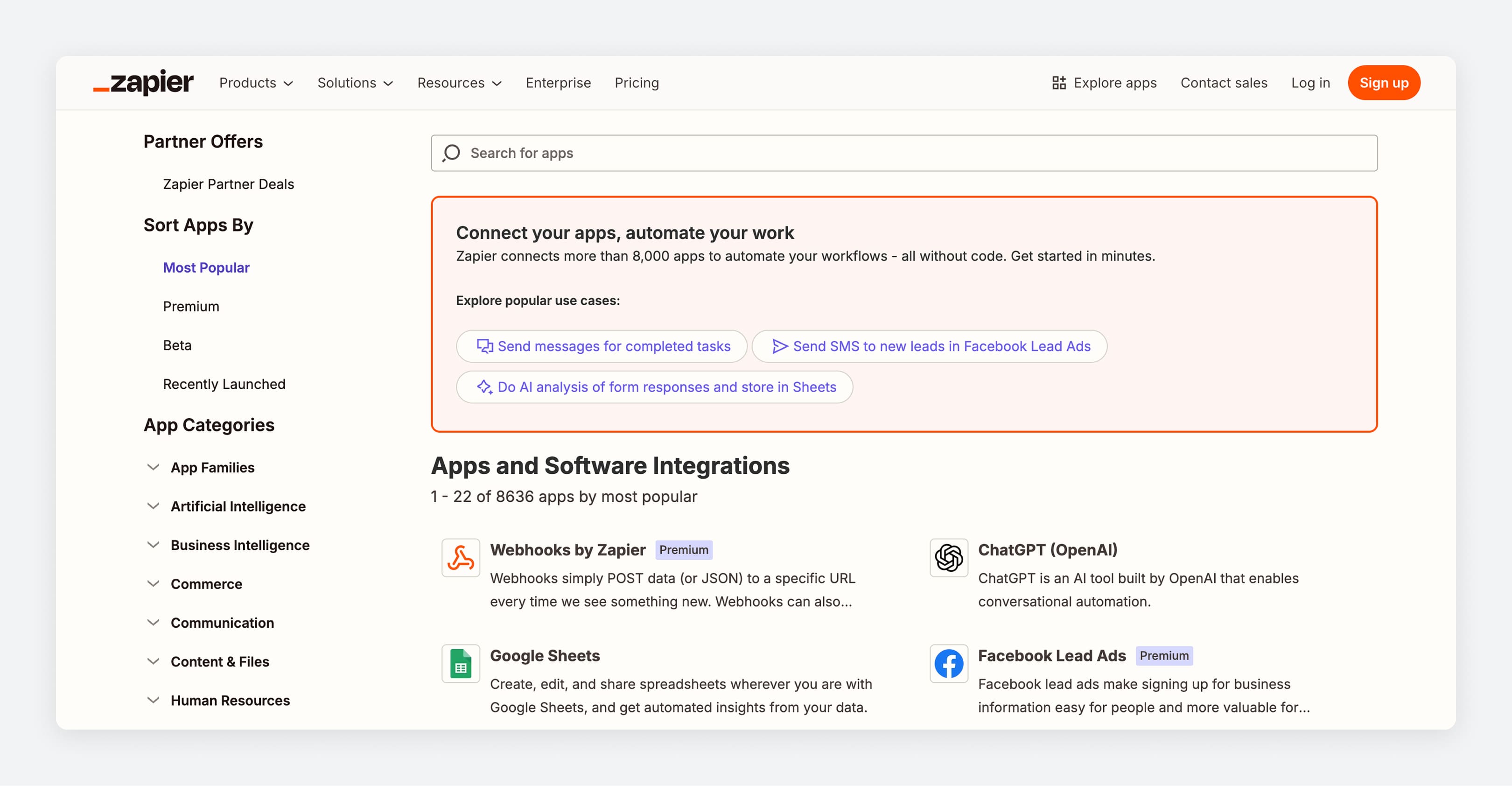
Case Study 2: TripAdvisor’s Location-Based Listings
TripAdvisor is a clear example of a directory-style website that uses programmatic SEO to great effect. They automatically create pages for virtually every city and location worldwide. Think, “Things to Do in [City]” or “Restaurants in [City]”.
Each page is populated by:
- Real user reviews
- Live hotel listings
- Attractions databases
This is indexation on a massive scale. In fact, TripAdvisor gains 7,000 contributions per hour! Each page is uniformly templated and localized for familiarity. With this approach, TripAdvisor has become one of the most recognizable websites in the world.
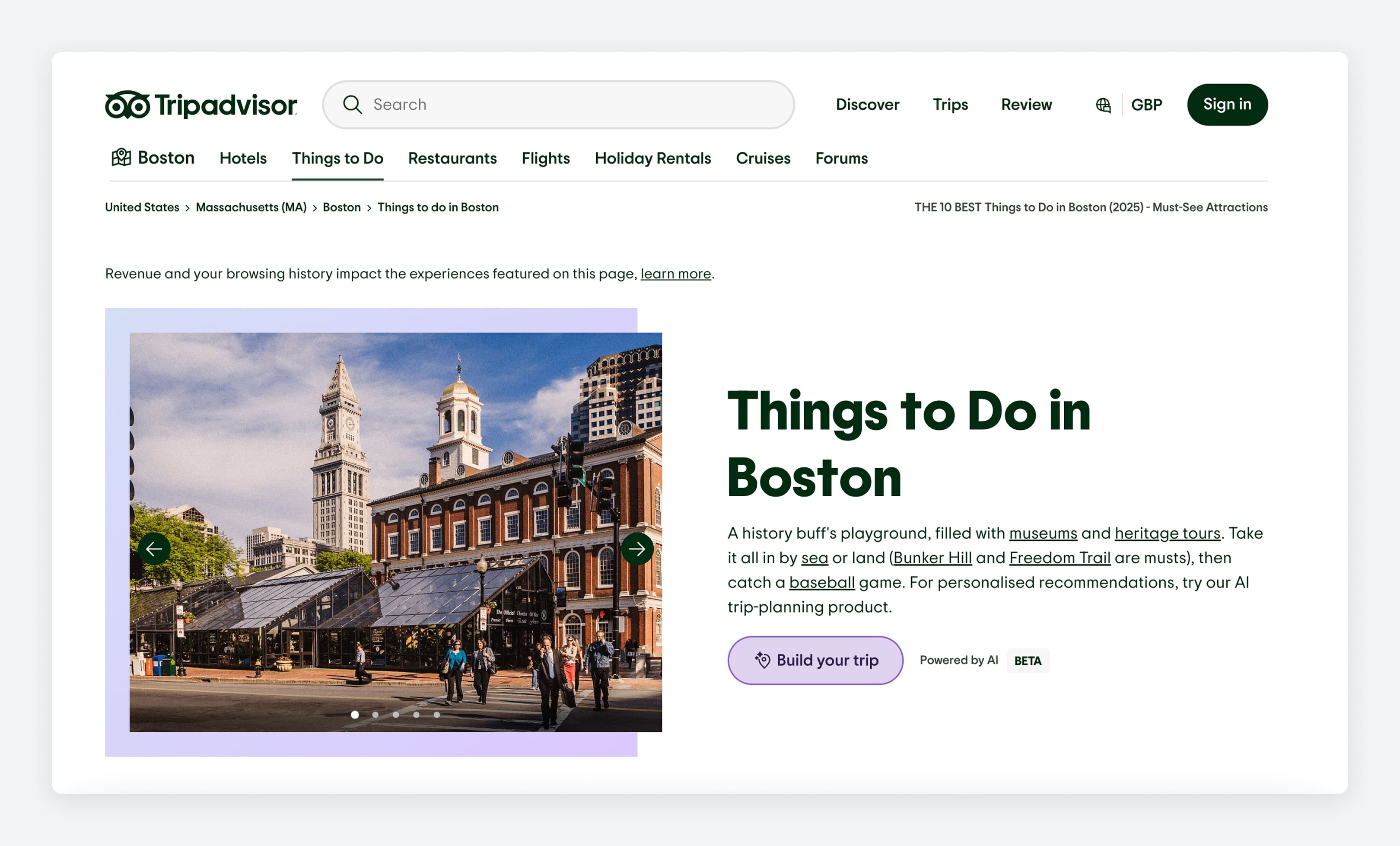
Case Study 3: NerdWallet’s Financial Comparison Pages
NerdWallet has one of the biggest libraries of financial content on the web. It uses programmatic SEO techniques to power it. You’ve probably seen long-tail targeting pages like:
- “Best cash back credit cards for groceries”
- “High-yield savings accounts with no fees”
Of course, such pages use structured datasets like interest rates and eligibility criteria to give relevant, clear breakdowns every user can benefit from. Their system makes it possible to scale high-intent comparison pages that drive affiliate revenue and search visibility rapidly. They apparently bring in more than 39m visitors a month!
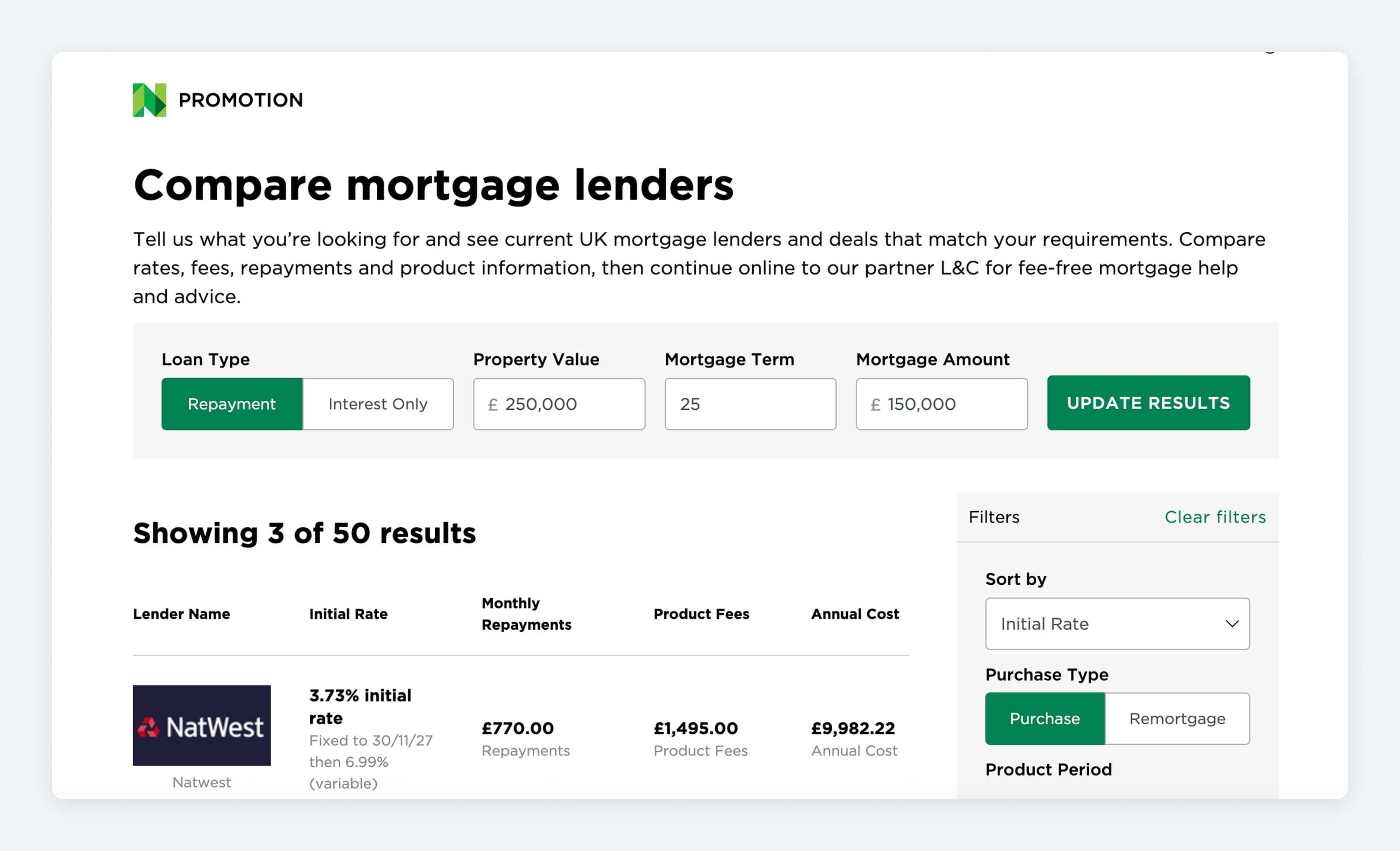
Lessons You Can Apply From These Examples
These programmatic SEO examples show you what’s possible with strategic thinking and patience. You don’t have to copy a successful business to do well. However, you should learn from them.
Here are our top takeaways from these success stories:
- Use structured data for niche pages - Zapier, TripAdvisor, and NerdWallet all use niche structured datasets to hone in on the traffic they want most.
- Use templates - when we land on a TripAdvisor page, for instance, we instantly recognize it and feel “at home”. We know where to look and trust what we see.
- Target long-tail & transactional queries - if you look closely at successful programmatic SEO pages, you’ll notice they all target high-intent search queries.
- Use internal linking & authority flow - Parent directory pages link down into specific templates, distributing link equity and helping search engines index deeper pages effectively.
- Refresh content - all successful programmatic SEO users update pages regularly to keep content relevant and trustworthy. This is great for both users and algorithms.
- Optimize for keyword volume - volume isn’t everything, but when you land on a perfect keyword strategy that you can scale, make the most of it.
Programmatic SEO Mistakes to Avoid
Programmatic SEO isn’t a shortcut to build an entire website overnight. Everyone considering the technique should go about it with the intention of providing relevant, high-quality pages. If you end up simply flooding the web with low-value content, you could damage your ranking and your reputation forever.
Here are the most common programmatic SEO mistakes and how to avoid them:
Duplicate and Thin Content Issues
Templates are essential, but you shouldn’t rely too heavily on them. When you end up with thousands of pages that are near-identical and lack enough unique data, your site can look “empty”. This is what we call “thin content”. As a result, Google may index/rank our pages poorly.
We recommend using AI or logic-based content generation to add unique value (stats, reviews) and adding canonical tags if pages are variations of the same content.
Poor Template Design and User Experience
Sadly, there are all too many templates that are designed to attract algorithms but fail when it comes to pleasing human users. Templates should never get in the way of loading times or user navigation.
Poor template design can lead to:
- High bounce rates
- Low engagement
- Miss conversions
- Poos “usefulness” signals
You should always test template usability before publishing and then test regularly while live. Remember, too, that 64% of all web searches are via mobile devices, so optimize pages for mobile devices whenever possible!
Ignoring Search Intent or Query Variability
It’s not all about volume. First-time programmatic SEO users often simply build lists of every possible keyword combo without evaluating whether there's actual search demand. They might also match keywords to templates that don’t match the user’s intent (transactional or informational, for example). This can lead to low content relevance.
Instead, use intent tools like Ahrefs to validate keywords, then group them by intent before assigning them to a template. If the keyword doesn’t seem particularly popular, don’t bother.
Not Monitoring Performance at Scale
It’s easy to publish your pages and then sit back. Too many businesses simply ignore analytics and assume their programmatic SEO efforts are paying off. However, this way, duplicates go unnoticed and underperforming templates stay active, damaging your results. Not only that, but wasting your budget, too.
Monitoring is key to all web maintenance, including programmatic SEO. Use tools like GA4 to consistently watch:
- Indexation rates
- Traffic
- CTR
- Bounce rates
- A/B testing results
How to Measure Success in Programmatic SEO
Success isn’t about the number of pages you generate, but how well those pages perform. To get a deep understanding of your programmatic SEO success, you need to monitor key metrics very closely.
Here’s how to spot what’s working and what needs attention:
Key Metrics to Track (Traffic, CTR, Indexing, etc.)
Here are the most important metrics for measuring the effectiveness of programmatic SEO:
- Organic traffic - gives you a good idea of overall visibility and effectiveness.
- CTR - helps assess meta title and description effectiveness.
- Indexation rate - shows you how much of your inventory Google is actually indexing.
- Bounce rate - tells you if users are finding value on your pages or simply clicking away.
- Conversions - directly ties your SEO performance to business impact.
- Keyword growth - tracks how many unique queries your programmatic pages are ranking for.
- Page load speed - tells you if your page speeds are getting in the way of conversions.
Tools to Monitor Performance at Scale
It’s impossible to track thousands of web pages by hand. Luckily, you don’t have to. There is a whole range of incredible tools you can use to help with everything from tracking performance to auditing.
Here are our top picks:
- Google Search Console - great for tracking multiple important metrics at the template or folder level.
- Google Analytics (GA4) - an easy way to analyze metrics by template.
- Looker Studio - one of the prime dashboard-builders on the market. Easily build custom dashboards for real-time monitoring of performance by page type.
- Screaming Frog - everything you need for crawling issues.
- Ahrefs/SEMrush - great for finding and managing your keywords.
- Content King - ideal for real-time SEO auditing for large websites.
Using Feedback Loops to Improve Template Quality
Don’t quit when you launch a page. The best programmatic SEO professionals use continuous feedback and iteration to constantly improve results.
Here’s how to do it:
- Monitor user behavior on page - use tools like heatmaps and scroll tracking to find out exactly how users interact with your pages, then see where/why bounces are happening.
- Test meta content - A/B testing is the best way to test multiple meta and schema variations and see which patterns work best.
- Update underperforming pages - don’t be afraid to make changes, even to successful pages. You might need to add new data fields or schema markup for better results.
- Trim deadweight - some page types are always consistently thin. If that’s the case, either cut them or merge them into broader clusters.
- Loop insights back into your system - don’t make corrections on a one-by-one basis. Instead, feed them into your generation logic. For example, use them to improve templates, or refine keyword targeting.
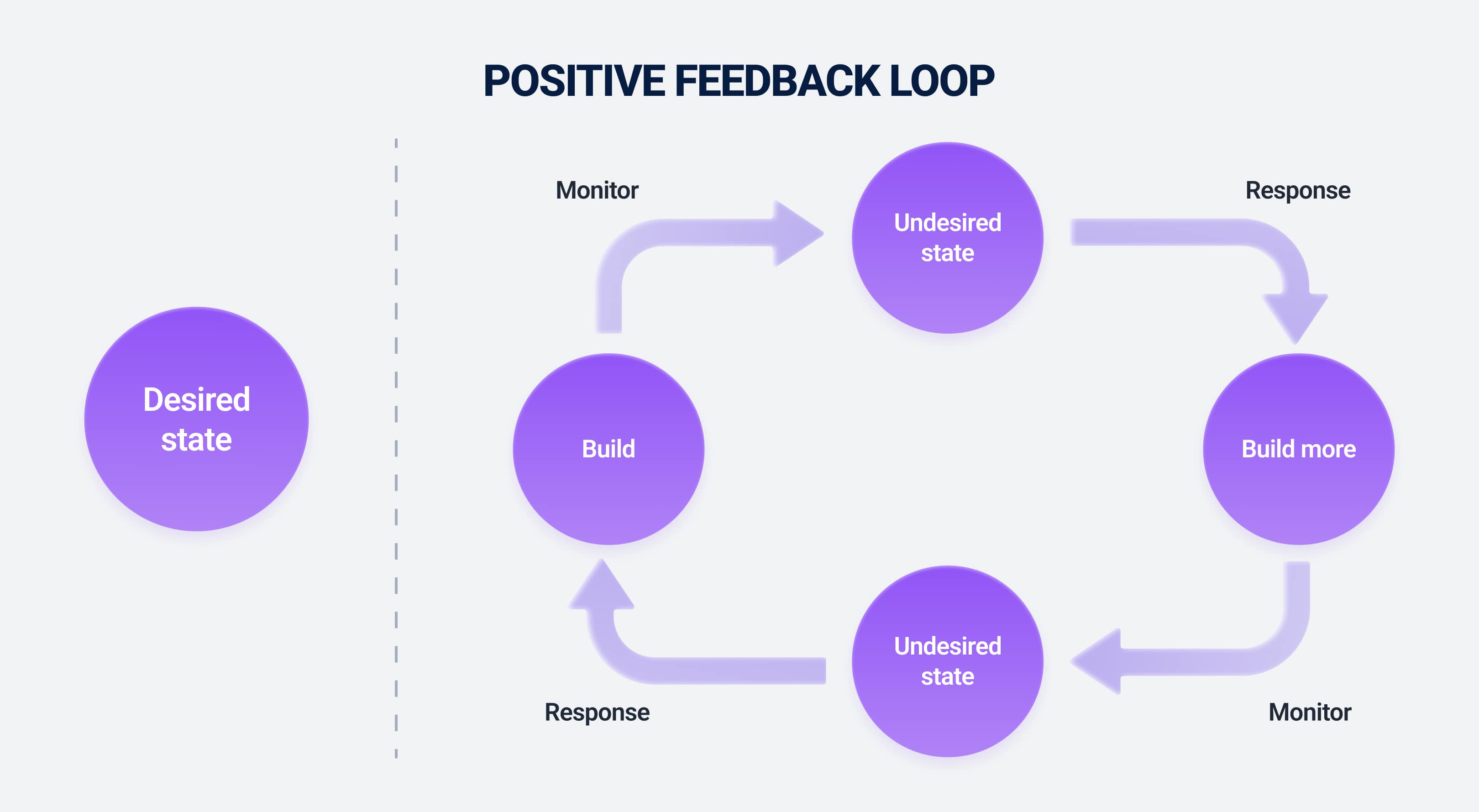
Final Thoughts
Programmatic SEO opens doors to scaling like never before. With the right tools and expertise, you can quickly generate and optimize hundreds, even thousands, or user- and algorithm-friendly pages that provide relevant, recognizable content.
The key thing to remember is that all your content must be valuable and original. You can and should use APIs to integrate real-time external data, but you should also be providing something new. Likewise, don’t rely solely on AI and templates to generate content. Always put your stamp on it.
SEO professionals like those at Influize specialize in boosting your online presence at lower cost than building an in-house team. Within a short space of time you could have a watertight programmatic SEO strategy and the expertise to pull it off by partnering with the experts.
Frequently Asked Questions
Is programmatic SEO suitable for small websites?
Yes, but with caution. Small websites can benefit from targeting long-tail, low-competition keywords. However, smaller sites should always focus on quality that retains their niche audience.
Can programmatic SEO lead to duplicate content issues?
If you don’t monitor your process carefully, then yes. However, you can avoid this problem by ensuring each page contains unique, valuable elements and using canonical tags.
How many pages should I generate with programmatic SEO?
There’s no single number that can answer this. We recommend starting small with just 50-500 pages of high quality content. In theory, you could expand to make thousands of pages, but only when you have a successful process in place.
Does Google penalize mass-generated pages?
Not necessarily. Google doesn’t specifically penalize scale. However, it does penalize low quality. If your pages are spammy or duplicative, they may be deindexed or flagged as thin content.
What are the risks of over-automating SEO content?
Relying too heavily on automated content can lead to surface-level problems like unnatural copy, but it can also cause deeper issues like duplicate content, misaligned user intent, poor content clustering, and missed differentiation opportunities
Can I combine programmatic SEO with local SEO?
Yes! In fact, we’d recommend doing so. Local landing pages are one of the best use cases for programmatic SEO. If your service operates in multiple locations, this is a perfect opportunity to cut manual labor in creating high-quality location pages that attract local bu

